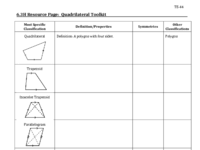IM1H 6.3 Part 2
Quadrilateral Toolkit
1. What angles of rotation does the triangle have? How many lines of reflection does the triangle have?
2. What angles of rotation does the square have? How many lines of reflection does the square have?
3. What angles of rotation does the pentagon have? How many lines of reflection does the pentagon have?
4. What angles of rotation does the hexagon have? How many lines of reflection does the hexagon have?
5. What angles of rotation does the octagon have? How many lines of reflection does the octagon have?
6. What angles of rotation does the nonagon have? How many lines of reflection does the nonagon have?
7. What patterns do you notice in terms of the number and characteristics of the lines of symmetry in a regular polygon. (Hint: think about even versus odd)
8. What patterns do you notice in terms of the angles of rotation when describing the rotational symmetry in a regular polygon?
Reflection
What are the main things you want to remember from this task?

